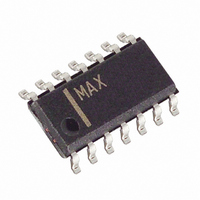MAX13448EESD+ Maxim Integrated Products, MAX13448EESD+ Datasheet - Page 13

MAX13448EESD+
Manufacturer Part Number
MAX13448EESD+
Description
IC TXRX RS485 FULL DUPLEX 14SOIC
Manufacturer
Maxim Integrated Products
Type
Transceiverr
Datasheet
1.MAX13448EESD.pdf
(14 pages)
Specifications of MAX13448EESD+
Number Of Drivers/receivers
1/1
Protocol
RS485
Voltage - Supply
3 V ~ 5.5 V
Mounting Type
Surface Mount
Package / Case
14-SOIC (3.9mm Width), 14-SOL
Operating Supply Voltage
3 V to 5 V
Supply Current
15 mA
Operating Temperature Range
- 40 C to + 85 C
Data Rate
0.5 Mbps
Mounting Style
SMD/SMT
Propagation Delay Time Ns
700 ns
Lead Free Status / RoHS Status
Lead free / RoHS Compliant
The enable inputs feature hot-swap capability. At the
input there are two NMOS devices, M1 and M2 (Figure
9). When V
turns on M2 and sets the SR latch that also turns on M1.
Transistor M2, a 1.5mA current sink, and M1, a 100µA
current sink, pull DE to GND through a 5kΩ resistor. M2
is designed to pull DE to the disabled state against an
external parasitic capacitance up to 100pF that can
drive DE high. After 7µs, the timer deactivates M2 while
M1 remains on, holding DE low against three-state leak-
ages that can drive DE high. M1 remains on until an
external source overcomes the required input current.
At this time, the SR latch resets and M1 turns off. When
M1 turns off, DE reverts to a standard, high-impedance
CMOS input.
The RS-485 standard specifies the load each receiver
places on the bus in terms of unit loads. An RS-485
compliant transmitter can drive 32 one-unit loads when
used with a 120Ω cable that is terminated on both ends
over a common-mode range of -7V to +12V. The
Figure 9. Simplified Structure of the Driver Enable Pin (DE)
DE
TIMER
V
TIMER
CC
5kΩ
M1
CC
ramps from zero, an internal 7µs timer
Applications Information
100μA
______________________________________________________________________________________
256 Transceivers on the Bus
500μA
10μs
M2
Hot-Swap Input Circuitry
SR LATCH
±80V Fault-Protected Full-Duplex
DE
(HOT SWAP)
MAX13448E is specified as 1/8 unit loads. This means
a compliant transmitter can drive up to 256 MAX13448E
devices. Reducing the common mode and/or changing
the characteristic impedance of the cable changes the
maximum number of receivers that can be used. Refer
to the TIA/EIA-485 specification for further details.
When the data rates for RS-485 are high relative to its
cable lengths, the system is subject to proper transmis-
sion line design. In most cases, a single, controlled-
impedance cable or trace should be used and should be
properly terminated on both ends with the characteristic
impedance of the cable/trace. RS-485 transceivers
should be connected to the cable/traces with minimum
length wires to prevent stubs. Star configurations and
improperly terminated cables can cause data loss. Refer
to the Applications section of the Maxim website or to
TIA/EIA publication TSB89 for further information.
The MAX13448E features reduced slew-rate drivers
that minimize EMI and reduce reflections caused by
improperly terminated cables, allowing error-free data
transmission up to 500kbps.
The Telecommunications Industry Association (TIA)
publishes the document TSB-89: Application
Guidelines for TIA/EIA-485-A that is a good reference
for determining maximum data rate vs. line length.
The MAX13448E transceivers are designed for bidirec-
tional data communications on multipoint bus transmis-
sion lines. Figure 10 shows a typical network application
circuit. To minimize reflections, terminate the line at both
ends in its characteristic impedance, and keep stub
lengths off the main line as short as possible.
Proper Termination and Cabling/Wiring
RS-485 Transceiver
Reduced EMI and Reflections
Typical Applications
Configurations
Line Length
13






